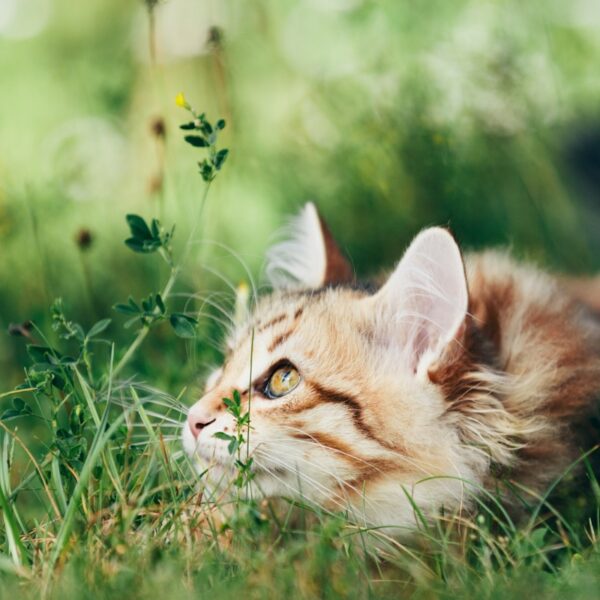Free-roaming neighborhood cats digging up your flowers and veggies and using them as a litter box? You’re not alone. Luckily, there are humane solutions!
Find out how to protect your young plants and seedlings from cat damage by making your garden space as unattractive to them as possible.
Jump to: Problems Caused by Cats | How to Keep Cats Away without Harming Them

This post may contain affiliate links. As an Amazon Associate, I also earn from qualifying purchases. You can read our disclosure information here–
Why are cats a problem?
If you’ve ever been tending your vegetable patch and grabbed a piece of cat poop with your bare hand, you’re probably well aware of why the presence of cats in your garden can be an issue. But did you know it’s more than just gross?
There are various reasons to want to keep cats out, and to want to keep your own cat indoors.
- Cats kill birds at a staggering rate (estimate is 1.3 – 4 billion birds each year in the U.S. alone). If you want your garden to be a haven for (song)birds, you can add a bird feeder with some song bird food, but you have to keep the cats out!
- Cat feces can contain pathogens, which is not ideal if you plan to eat your veggies.
- Cats like to dig, which can disturb, damage and even kill the plants in your flowerbeds.
- Free-roaming cats might attack your own cat or pass diseases to it. Their presence is also less than ideal if you keep chickens or other pets in your garden.
- Cats may use your garden furniture as a scratching post or pee on it.
- Not all gardens are safe for cats. For example, what happens if one falls in your pond or swimming pool and can’t make its way out?
Cat Lovers Take Note! Did you know that several vegetable plants in your garden are poisonous to our beloved cats? For example: Eggplant, Onions, Garlic, Chives, Leeks, Scallions, and Shallots!
How to keep cats out of your garden: 8 tips
Although cats can be extremely annoying, there’s no need to harm any that invade your garden. Poison, chemicals, shooting, and the like are illegal, cruel, terrible for neighborhood relations and sometimes dangerous to other pets and even children.
So what can you do? Actually, a lot. Here are 8 handy tips that will help you make your garden as unattractive to cats as possible. Try implementing as many as you can for the best results.

1. Remove Food Sources
Think about whether there’s anything lying around your garden or shed that’s edible or smells attractive to cats. Remove or lock up the following:
- Garbage. Always ensure bags and bins are 100% closed.
- Pet food. This includes fish food if you have a pond; it’s made of fish, so cats will eat it. If you store it in your shed, make sure cats can’t get in.
- Fish. Speaking of ponds, if you have one, it may make sense to block it off so cats can’t come looking for a fishy snack.
- Rodents. They are attracted to plant-based foods that cats don’t like, but in turn form a cat food source themselves. Clean around bird feeders and keep anything edible locked away.
- BBQ and outdoor meal leftovers. Clean everything, including the grill, to prevent enticing meaty smells from attracting cats.

It’s also a good idea to remove or block access to any comfy hang-out spots. Cats love to bask in the sun and curl up in warm and secluded places. This can include cushioned garden furniture, bins and boxes, cloths and tarps, and especially sheds and greenhouses.
Lastly, do you grow plants like catnip and other species in the mint family, a kiwi bush, silver vine, or lemongrass?
Some popular garden plants are irresistible to cats. If you’re struggling to keep your neighborhood felines out, it’s worth considering whether you should get rid of these.

2. Sound-Based Repellent Devices
Cats and other critters can hear higher-pitched frequencies than humans. This means that one very neat and cruelty-free solution that will help get rid of cats is a motion-activated, sound-based repellent device.
Basically, when a cat stalks into the range of the device, it starts producing a very high-pitched “EEEEP”. You can’t hear it, but the cat can, and it’ll soon get so annoyed by it that it prefers trying its luck elsewhere.
Some devices even emit light flashes (visible and infrared), imitate owl noises, and more.
It doesn’t always work, but plenty of people have had good results with it, so it’s definitely worth a shot.
Many sound-based repellent devices will also scare off martens, rodents (including rabbits and squirrels), raccoons, foxes, deer, and more.
The downside is that they’re also highly annoying to dogs, so if your furry friend has access to your garden at night, that can pose a problem.
3. Motion-Activated Sprinklers
Speaking of motion-activated devices, here’s another good one: sprinklers. The only thing a cat hates more than water is water that comes unexpectedly!
The concept of motion-activated sprinklers is similar to the aforementioned sound-based devices. A cat or other animal gets in its range, it shoots a jet of water (and optionally makes an annoying or threatening sound), and the intruder hopefully decides it’s not worth it to stick around.

4. Digging Barriers
Cats like soft surfaces like dirt flowerbeds. It allows them to dig, which they do to bury their excrement, and they like the comfortable feel on their paws and to lay down and take a nap.
As such, one great way to make your garden much less attractive to cats is to add annoying, uncomfortable spikes. A system that prevents them from digging into your flowerbeds altogether, like the classic pointy “scat mat“, is an effective option.
For a homemade solution, some folks have had good success with simply sticking chopsticks, plastic forks or kebab sticks in the ground. Laying down chicken wire can also help prevent any digging from taking place.

5. Scent-Based Repellents
Cats have extremely sensitive noses. Although this can cause them to be attracted to your garden, like if there’s garbage out or you grow plants they like, you can also use it in your favor.
First off, there are different types of commercial scent-based cat repellents out there:
- Granules and sprays with botanical oils and other scents cats dislike
- Granules and sprays containing mountain lion, coyote or wolf pee to scare cats
Aside from this, you can also use natural essential oil concentrates and various spices that cats dislike. They’ll avoid a bunch of different scents:
- Spices: cayenne, black pepper, mustard powder, cinnamon
- Oils: citrus and citronella, lavender, rosemary, pine, eucalyptus

Scent-based repellents, both store-bought and DIY, tend to have mixed reviews. Some folks are highly enthusiastic, others say the cats didn’t care at all!
Since most of these potential solutions don’t break the bank, I’d say they’re more than worth giving a try.
Tip: Some essential oils, like tea tree, are unattractive but unfortunately also toxic to cats. Even if they don’t eat oil-covered plants, they can get the oil on their paws and ingest it while grooming, so check first to avoid accidentally poisoning the neighbors’ beloved kitty. Always dilute essential oils.
6. Cat-Repelling Plants
Although planting certain plants isn’t going to be a surefire way to keep cats out of your garden, it’s an excellent addition to your arsenal of cat-repelling measures.
Remember, it’s all about combining different strategies to make your space as unattractive to them as possible!
Just as there are plants that cats adore, there are others they hate. The one to start with is appropriately named the scaredy cat plant, scientific name Coleus canina.
Although as with most methods, there are unfortunately no scientific studies that prove or disprove its effectiveness, gardeners generally report that most cats really don’t like the scent of this plant.
You do need to wear gloves (and maybe hold your breath!) when handling it, though, because it emits a skunky odor that’s noticeable to humans when the leaves are disturbed.
Other plants you can try include:
- Rue (Ruta graveolens)
- Lavender (Lavandula sp.)
- Rosemary (Salvia rosmarinus)
- Citrus trees

7. Fencing
Not having much success with the methods we’ve discussed so far? If you’re exasperated and don’t mind spending a little to keep your garden cat-free, you may want to consider installing fencing.
Now, I can hear you thinking: how does a fence keep out a cat unless it’s about 15 feet tall? You can of course place spikes at the top, but you may unintentionally end up hurting a cat this way.
The trick is to angle the top of the fence outwards. You can go for a pre-slanted fence, but there are also angled fence toppers available that you can attach to an existing one.
Alternatively if you already have a fence, but it is not effective in keeping neighborhood cats out, you could try this kind of cat prevention conversion kit from Amazon.

Aside from this, I also really like the following:
8. Fence Rollers
Fence alone not working or don’t want to have an unsightly angled fence or fence topper? There is another solution: Oscillot® cat-proof fence kits.
It’s simple but kind of genius. The system is little more than an aluminum bar with paddles that spin when pressure is applied. When a cat jumps up in order to try and gain a foothold on the fence, it instead hits the paddles, which will roll and cause it to fall back down unhurt.
These fence kits are generally used to keep cats in (as in the short video graciously provided by a friend of mine below), not out, but there’s no reason they wouldn’t work the other way round.
It can be pricey to install one of these fence rollers along your property line. Still, if you really need to keep cats out, like if you keep chickens or other birds, it’s a highly effective solution.
If you like my articles about cooking and gardening, subscribe to my weekly newsletter, where I share free recipes and gardening tutorials.
Cat Video Below
Kanine, J., & Mengak, M. T. (2014). Managing wildlife damage: Feral cats (felis catus).
If you like my articles about cooking and gardening, subscribe to my weekly newsletter, where I share free recipes and gardening tutorials.


As a cat lover AND a gardener, I greatly appreciate all your tips, your information (who knew over 1 BILLION birds are killed by cats in the US each year!) and especially the info on vegetable plants that are poisonous to cats! Thank you Dorothy!
I also learned a lot of surprising facts by researching this post. Now,to figure out how to keep rabbits out of the garden!!!
Thank you for the tips, I have an elderly neighbor who has threatened to kill the cats that poop in her garden and have offered her alternatives. these will add to the list!
Yes, cats in the garden can be pesky sometimes and not all garden lovers are cat lovers. I love both gardens and cats, but I hate the cute rabbits and beautiful deer! Good luck with your neighbor. It sounds like you are not at war yet so maybe some tips and gentle words will help.